Iron-Doped Nickel Hydroxide Nanosheets as Efficient Electrocatalysts in Electrochemical Water Splitting
Abstract
1. Introduction
2. Results and Discussion
2.1. XRD Analysis
2.2. FESEM and TEM Analysis
2.3. XPS Analysis
2.4. Electrochemical Characterization
2.4.1. Electrocatalytic Performance of HER
2.4.2. Electrocatalytic Performance of OER
2.5. Electrochemical Performance of Water Splitting
3. Experimental Section
3.1. Materials and Methods
3.2. Preparation of Fe Doped Ni(OH)2
3.3. Physicochemical Characterization
3.4. Electrochemical Characterization
4. Conclusions
Author Contributions
Funding
Data Availability Statement
Conflicts of Interest
References
- Xue, B.W.; Zhang, C.H.; Wang, Y.Z.; Xie, W.W.; Li, N.-W.; Yu, L. Recent progress of Ni–Fe layered double hydroxide and beyond towards electrochemical water splitting. Nanoscale Adv. 2020, 2, 5555–5566. [Google Scholar] [CrossRef]
- Suen, N.-T.; Hung, S.-F.; Quan, Q.; Zhang, N.; Xu, Y.-J.; Chen, H.M. Electrocatalysis for the oxygen evolution reaction: Recent development and future perspectives. Chem. Soc. Rev. 2017, 46, 337–365. [Google Scholar] [CrossRef] [PubMed]
- Vij, V.; Sultan, S.; Harzandi, A.M.; Meena, A.; Tiwari, J.N.; Lee, W.-G.; Yoon, T.; Kim, K.S. Nickel-based electrocatalysts for energy-related applications: Oxygen reduction, oxygen evolution, and hydrogen evolution reactions. Acs Catal. 2017, 7, 7196–7225. [Google Scholar] [CrossRef]
- Maiyalagan, T.; Jarvis, K.A.; Therese, S.; Ferreira, P.J.; Manthiram, A. Spinel-type lithium cobalt oxide as a bifunctional electrocatalyst for the oxygen evolution and oxygen reduction reactions. Nat. Commun. 2014, 5, 3949. [Google Scholar] [CrossRef]
- Kale, V.N.; Maiyalagan, T. Lollipop-shaped interconnected MnO2 nanotube/Co3O4 polyhedron composite derived from zeolitic-imidazolate framework-67 as an efficient electrocatalyst for oxygen evolution reaction. Mater. Today Chem. 2022, 26, 101063. [Google Scholar] [CrossRef]
- Guruprasad, K.; Maiyalagan, T.; Shanmugam, S. Phosphorus doped MoS2 nanosheet promoted with nitrogen, sulfur dual doped reduced graphene oxide as an effective electrocatalyst for hydrogen evolution reaction. ACS Appl. Energy Mater. 2019, 2, 6184–6194. [Google Scholar] [CrossRef]
- Zhang, J.; Zhang, Q.; Feng, X. Support and interface effects in water-splitting electrocatalysts. Adv. Mater. 2019, 31, 1808167. [Google Scholar] [CrossRef]
- Jiao, Y.; Zheng, Y.; Jaroniec, M.; Qiao, S.Z. Design of electrocatalysts for oxygen-and hydrogen-involving energy conversion reactions. Chem. Soc. Rev. 2015, 44, 2060–2086. [Google Scholar] [CrossRef]
- Xu, X.; Shao, Z.; Jiang, S.P. High-Entropy Materials for Water Electrolysis. Energy Technol. 2022, 10, 2200573. [Google Scholar] [CrossRef]
- Tang, J.; Xu, X.; Tang, T.; Zhong, Y.; Shao, Z. Perovskite-Based Electrocatalysts for Cost-Effective Ultrahigh-Current-Density Water Splitting in Anion Exchange Membrane Electrolyzer Cell. Small Methods 2022, 6, 2201099. [Google Scholar] [CrossRef]
- Jothi, V.R.; Karuppasamy, K.; Maiyalagan, T.; Rajan, H.; Jung, C.Y.; Yi, S.C. Corrosion and alloy engineering in rational design of high current density electrodes for efficient water splitting. Adv. Energy Mater. 2020, 10, 1904020. [Google Scholar] [CrossRef]
- Qin, C.; Tian, S.; Jiang, Z.-J.; Maiyalagan, T.; Jiang, Z. Low temperature plasma-assisted synthesis and modification of water splitting electrocatalysts. Electrochim. Acta 2023, 449, 142179. [Google Scholar] [CrossRef]
- Yi, H.; Liu, S.; Lai, C.; Zeng, G.; Li, M.; Liu, X.; Chen, L. Recent advance of transition-metal-based layered double hydroxide nanosheets: Synthesis, properties, modification, and electrocatalytic applications. Adv. Energy Mater. 2021, 11, 2002863. [Google Scholar] [CrossRef]
- Zhu, J.; Hu, L.; Zhao, P.; Lee, L.Y.S.; Wong, K.Y. Recent advances in electrocatalytic hydrogen evolution using nanoparticles. Chem. Rev. 2019, 120, 851–918. [Google Scholar] [CrossRef] [PubMed]
- Lee, S.-Y.; Oh, H.-J.; Kim, M.; Cho, H.-S.; Lee, Y.-K. Insights into enhanced activity and durability of hierarchical Fe-doped Ni(OH)2/Ni catalysts for alkaline oxygen evolution reaction: In situ XANES studies. Appl. Catal. B 2023, 324, 122269. [Google Scholar] [CrossRef]
- Saraj, C.S.; Singh, S.C.; Shukla, A.; Yu, W.; Fayyaz, M.U.; Guo, C. Single-step and sustainable fabrication of Ni(OH)2/Ni foam water splitting catalysts via electric field assisted pulsed laser ablation in liquid. Chem. Electro. Chem. 2021, 8, 209–217. [Google Scholar] [CrossRef]
- Han, L.; Dong, S.; Wang, E. Transition-metal (Co, Ni, and Fe)-based electrocatalysts for the water oxidation reaction. Adv. Mater. 2016, 28, 9266–9291. [Google Scholar] [CrossRef]
- Mahala, C.; Devi Sharma, M.; Basu, M. Fe-Doped Nickel Hydroxide/Nickel Oxyhydroxide Function as an Efficient Catalyst for the Oxygen Evolution Reaction. ChemElectroChem 2019, 6, 3488–3498. [Google Scholar] [CrossRef]
- Pang, L.; Liu, W.; Zhao, X.; Zhou, M.; Qin, J.; Yang, J. Engineering electronic structures of nickel cobalt phosphide via iron doping for efficient overall water splitting. Chem. Electro. Chem. 2020, 7, 4913–4921. [Google Scholar] [CrossRef]
- Rathore, D.; Banerjee, A.; Pande, S. Bifunctional tungsten-doped Ni(OH)2/NiOOH nanosheets for overall water splitting in an alkaline medium. ACS Appl. Nano Mater. 2022, 5, 2664–2677. [Google Scholar] [CrossRef]
- Yan, J.; Kong, L.; Ji, Y.; White, J.; Li, Y.; Zhang, J.; Ma, T. Single atom tungsten doped ultrathin α-Ni(OH)2 for enhanced electrocatalytic water oxidation. Nat. Commun. 2019, 10, 2149. [Google Scholar] [CrossRef]
- Liu, X.; Qin, H.; Ye, Z.; Yao, D.; Miao, W.; Mao, S. Interconnected Mn-doped Ni(OH)2 nanosheet layer for bifunctional urea oxidation and hydrogen evolution: The relation between current drop and urea concentration during the long-term operation. ACS EST Eng. 2022, 2, 853–862. [Google Scholar] [CrossRef]
- Jian, J.; Kou, X.; Wang, H.; Chang, L.; Zhang, L.; Gao, S.; Xu, Y.; Yuan, H. Fascinating Tin Effects on the Enhanced and Large-Current-Density Water Splitting Performance of Sn–Ni(OH)2. ACS Appl. Mater. Interfaces 2021, 13, 42861–42869. [Google Scholar] [CrossRef] [PubMed]
- Zhao, P.; Ma, L.; Guo, J. Vanadium doped nickel hydroxide nanosheets for efficient overall alkaline water splitting. J. Phys. Chem. Solids 2022, 164, 110634. [Google Scholar] [CrossRef]
- Babar, P.; Lokhande, A.C.; Karade, V.; Pawar, B.; Gil Gang, M.; Pawar, S.; Kim, J.H. Bifunctional 2D electrocatalysts of transition metal hydroxide nanosheet arrays for water splitting and urea electrolysis. ACS Sustain. Chem. Eng. 2019, 7, 10035–10043. [Google Scholar] [CrossRef]
- Krehula, S.; Ristić, M.; Wu, C.; Li, X.; Jiang, L.; Wang, J.; Musić, S. Influence of Fe(III) doping on the crystal structure and properties of hydrothermally prepared β-Ni(OH)2 nanostructures. J. Alloys Compd. 2018, 750, 687–695. [Google Scholar] [CrossRef]
- Kou, T.; Wang, S.; Hauser, J.L.; Chen, M.; Oliver, S.R.J.; Ye, Y.; Guo, J.; Li, Y. Ni foam-supported Fe-doped β-Ni(OH)2 nanosheets show ultralow overpotential for oxygen evolution reaction. ACS Energy Lett. 2019, 4, 622–628. [Google Scholar] [CrossRef]
- Zhu, K.; Liu, H.; Li, M.; Li, X.; Wang, J.; Zhu, X.; Yang, W. Atomic-scale topochemical preparation of crystalline Fe3+-doped β-Ni(OH)2 for an ultrahigh-rate oxygen evolution reaction. J. Mater. Chem. A 2017, 5, 7753–7758. [Google Scholar] [CrossRef]
- Stevens, M.B.; Trang, C.D.M.; Enman, L.J.; Deng, J.; Boettcher, S.W. Reactive Fe-sites in Ni/Fe (oxy) hydroxide are responsible for exceptional oxygen electrocatalysis activity. J. Am. Chem. Soc. 2017, 139, 11361–11364. [Google Scholar] [CrossRef]
- Long, X.; Li, J.; Xiao, S.; Yan, K.; Wang, Z.; Chen, H.; Yang, S. A strongly coupled graphene and FeNi double hydroxide hybrid as an excellent electrocatalyst for the oxygen evolution reaction. Angew. Chem. Int. Ed. 2014, 53, 7584–7588. [Google Scholar] [CrossRef]
- Qiao, X.; Kang, H.; Li, Y.; Cui, K.; Jia, X.; Liu, H.; Wu, G. Porous Fe-Doped β-Ni(OH)2 Nanopyramid Array Electrodes for Water Splitting. ACS Appl. Mater. Interfaces 2020, 12, 36208–36219. [Google Scholar] [CrossRef] [PubMed]
- Suryanto, B.H.R.; Wang, Y.; Hocking, R.K.; Adamson, W.; Zhao, C. Overall electrochemical splitting of water at the heterogeneous interface of nickel and iron oxide. Nat. Commun. 2019, 10, 5599. [Google Scholar] [CrossRef] [PubMed]
- Guo, C.X.; Li, C.M. Room temperature-formed iron-doped nickel hydroxide on nickel foam as a 3D electrode for low polarized and high-current-density oxygen evolution. Chem. Commun. 2018, 54, 3262–3265. [Google Scholar] [CrossRef] [PubMed]
- Wu, Y.; Ji, S.; Wang, H.; Pollet, B.G.; Wang, X.; Wang, R. A highly efficient water electrolyser cell assembled by asymmetric array electrodes based on Co, Fe-doped Ni(OH)2 nanosheets. Appl. Surf. Sci. 2020, 528, 146972. [Google Scholar] [CrossRef]
- Wang, Y.; Wang, J.; Xie, T.; Zhu, Q.; Zeng, D.; Li, R.; Zhang, X.; Liu, S. Ru doping in Ni(OH)2 to accelerate water reduction kinetics for efficient hydrogen evolution reaction. Appl. Surf. Sci. 2019, 485, 506–512. [Google Scholar] [CrossRef]
- Chen, X.; Yang, L.; Huang, Y.; Ge, S.; Zhang, H.; Cui, Y.; Xiao, Z. Fabrication of a Hierarchical Ni(OH)2@Ni3S2/Ni Foam Electrode from a Prussian Blue Analogue-Based Composite with Enhanced Electrochemical Capacitive and Electrocatalytic Properties. Chem.–A Eur. J. 2020, 26, 1111–1116. [Google Scholar] [CrossRef]
- Patil, B.; Satılmış, B.; Khalily, M.A.; Uyar, T. Atomic layer deposition of NiOOH/Ni(OH)2 on PIM-1-based N-doped carbon nanofibers for electrochemical water splitting in alkaline medium. Chem. Sus. Chem. 2019, 12, 1469–1477. [Google Scholar] [CrossRef]
- Zhao, G.; Lin, Y.; Rui, K.; Zhou, Q.; Chen, Y.; Dou, S.X.; Sun, W. Epitaxial growth of Ni(OH)2 nanoclusters on MoS2 nanosheets for enhanced alkaline hydrogen evolution reaction. Nanoscale 2018, 10, 19074–19081. [Google Scholar] [CrossRef]
- Briones-Martínez, R.; Garcia-Gomez, N.A.; Sepúlveda-Guzmán, S.; de la Parra-Arciniega, S.M.; Sánchez, E.M. Self-supported Ni3Se2/Ni(OH)2 and Ni3Se2 on Ni-foam: Nanostructured arrays for the hydrogen evolution reaction. J. Nanoparticle Res. 2020, 22, 1–10. [Google Scholar] [CrossRef]
- Subbaraman, R.; Tripkovic, D.; Strmcnik, D.; Chang, K.C.; Uchimura, M.; Paulikas, A.P.; Markovic, N.M. Enhancing hydrogen evolution activity in water splitting by tailoring Li+-Ni(OH)2-Pt interfaces. Science 2011, 334, 1256–1260. [Google Scholar] [CrossRef]
- Patil, K.; Babar, P.; Bae, H.; Jo, E.; Jang, J.S.; Bhoite, P.; Kolekar, S.; Kim, J.H. Enhanced electrocatalytic activity of a layered triple hydroxide (LTH) by modulating the electronic structure and active sites for efficient and stable urea electrolysis. Sustain. Energy Fuels 2022, 6, 474–483. [Google Scholar] [CrossRef]
- Cheng, W.; Xue, L.; Wang, J.; Chen, X.; Sun, H.; Huang, C.; Yao, W. Surface-engineered Ni(OH)2/PtNi nanocubes as cocatalysts for photocatalytic hydrogen production. ACS Appl. Nano Mater. 2021, 4, 8390–8398. [Google Scholar] [CrossRef]
- Deng, Y.; Lai, W.; He, X.; Xu, L.; Xu, B. Facile electrochemical synthesis of Ni(OH)2/MoSx catalyst on oxidized carbon fiber for efficient alkaline hydrogen evolution reaction. Chem. Eng. Process. Process Intensif. 2020, 155, 108090. [Google Scholar] [CrossRef]
- Jia, X.; Wang, Y.; Tang, J.; Song, K.; Zhang, H.; Lin, B.; Zheng, H. FeNi-LDH@Ni film modified stainless-steel as self-supported electrodes for efficient and stable overall water splitting in alkaline environments. Surf. Coat. 2023, 464, 129502. [Google Scholar] [CrossRef]
- Li, G.; Wu, X.; Guo, H.; Guo, Y.; Chen, H.; Wu, Y.; Zheng, J.; Li, X. Plasma transforming Ni(OH)2 nanosheets into porous nickel nitride sheets for alkaline hydrogen evolution. ACS Appl. Mater. Interfaces 2020, 12, 5951–5957. [Google Scholar] [CrossRef]
- Li, D.; Hao, G.; Guo, W.; Liu, G.; Li, J.; Zhao, Q. Highly efficient Ni nanotube arrays and Ni nanotube arrays coupled with NiFe layered-double-hydroxide electrocatalysts for overall water splitting. J. Power Sources 2020, 448, 227434. [Google Scholar] [CrossRef]
- Xiao, C.; Zhang, B.; Li, D. Partial-sacrificial-template synthesis of Fe/Ni phosphides on Ni foam: A strongly stabilized and efficient catalyst for electrochemical water splitting. Electrochim. Acta 2017, 242, 260–267. [Google Scholar] [CrossRef]
- Wang, X.; He, P.; Yang, Y.; Zhang, F.; Tang, J.; Que, R. In situ synthesis of Fe-doped NiC2O4 nanorods for efficient oxygen evolution activity and overall water splitting. Electrochim. Acta 2020, 345, 136228. [Google Scholar] [CrossRef]
- Wu, Z.; Zou, Z.; Huang, J.; Gao, F. Fe-doped NiO mesoporous nanosheets array for highly efficient overall water splitting. J. Catal. 2018, 358, 243–252. [Google Scholar] [CrossRef]
- Youn, D.H.; Park, Y.B.; Kim, J.Y.; Magesh, G.; Jang, Y.J.; Lee, J.S. One-pot synthesis of NiFe layered double hydroxide/reduced graphene oxide composite as an efficient electrocatalyst for electrochemical and photoelectrochemical water oxidation. J. Power Sources 2015, 294, 437–443. [Google Scholar] [CrossRef]
- Jadhav, H.S.; Roy, A.; Desalegan, B.Z.; Seo, J.G. An advanced and highly efficient Ce assisted NiFe-LDH electrocatalyst for overall water splitting. Sustain. Energy Fuels 2020, 4, 312–323. [Google Scholar] [CrossRef]
- Zhang, B.; Jiang, K.; Wang, H.; Hu, S. Fluoride-Induced Dynamic Surface Self-Reconstruction Produces Unexpectedly Efficient Oxygen-Evolution Catalyst. Nano Lett. 2019, 19, 530–537. [Google Scholar] [CrossRef] [PubMed]
- Lu, X.; Zhao, C. Electrodeposition of hierarchically structured three-dimensional nickel–iron electrodes for efficient oxygen evolution at high current densities. Nat. Commun. 2015, 6, 6616. [Google Scholar] [CrossRef] [PubMed]
- Bandal, H.A.; Jadhav, A.R.; Kim, H. Facile synthesis of bicontinuous Ni3Fe alloy for efficient electrocatalytic oxygen evolution reaction. J. Alloy. Compd. 2017, 726, 875–884. [Google Scholar] [CrossRef]
- Dai, L.; Chen, Z.; Li, L.; Yin, P.; Liu, Z.; Zhang, H. Ultrathin Ni (0)-Embedded Ni(OH)2 Heterostructured Nanosheets with Enhanced Electrochemical Overall Water Splitting. Adv. Mater. 2020, 32, 1906915. [Google Scholar] [CrossRef]
- Dinh, K.N.; Zheng, P.; Dai, Z.; Zhang, Y.; Dangol, R.; Zheng, Y.; Li, B.; Zong, Y.; Yan, Q. Ultrathin porous NiFeV ternary layer hydroxide nanosheets as a highly efficient bifunctional electrocatalyst for overall water splitting. Small 2018, 14, 1703257. [Google Scholar] [CrossRef]
- Wang, P.; Lin, Y.; Wan, L.; Wang, B. Autologous growth of Fe-doped Ni(OH)2 nanosheets with low overpotential for oxygen evolution reaction. Int. J. Hydrogen Energy 2020, 45, 6416–6424. [Google Scholar] [CrossRef]
- McCrory, C.C.L.; Jung, S.; Ferrer, I.M.; Chatman, S.M.; Peters, J.C.; Jaramillo, T.F. Benchmarking hydrogen evolving reaction and oxygen evolving reaction electrocatalysts for solar water splitting devices. J. Am. Chem. Soc. 2015, 137, 4347–4357. [Google Scholar] [CrossRef]
- Wang, S.; Lu, A.; Zhong, C.-J. Hydrogen production from water electrolysis: Role of catalysts. Nano Converg. 2021, 8, 1–23. [Google Scholar] [CrossRef]
- Xue, J.Y.; Li, F.L.; Zhao, Z.Y.; Li, C.; Ni, C.Y.; Gu, H.W.; Lang, J.P. A hierarchically-assembled Fe–MoS2/Ni3S2/nickel foam electrocatalyst for efficient water splitting. Dalton Trans. 2019, 48, 12186–12192. [Google Scholar] [CrossRef]
- Zheng, M.; Du, J.; Hou, B.; Xu, C.L. Few-Layered Mo1−xWxS2 Hollow Nanospheres on Ni3S2 Nanorod Heterostructure as Robust Electrocatalysts for Overall Water Splitting. ACS Appl. Mater. Interfaces 2017, 9, 26066–26076. [Google Scholar] [CrossRef] [PubMed]
- Li, Q.; Wang, D.; Han, C.; Ma, X.; Lu, Q.; Xing, Z.; Yang, X. Construction of amorphous interface in an interwoven NiS/NiS2 structure for enhanced overall water splitting. J. Mater. Chem. A 2018, 6, 8233–8237. [Google Scholar] [CrossRef]
- Luo, J.; Im, J.-H.; Mayer, M.T.; Schreier, M.; Nazeeruddin, M.K.; Park, N.-G.; Tilley, S.D.; Fan, H.J.; Grätzel, M. Water photolysis at 12.3% efficiency via perovskite photovoltaics and Earth-abundant catalysts. Science 2014, 345, 1593–1596. [Google Scholar] [CrossRef]
- Zhong, X.; Tang, J.; Wang, J.; Shao, M.; Chai, J.; Wang, S.; Pan, H. 3D heterostructured pure and N-Doped Ni3S2/VS2 nanosheets for high efficient overall water splitting. Electrochim. Acta 2018, 269, 55–61. [Google Scholar] [CrossRef]
- Wu, C.; Liu, B.; Wang, J.; Su, Y.; Yan, H.; Ng, C.; Wei, J. 3D structured Mo-doped Ni3S2 nanosheets as efficient dual-electrocatalyst for overall water splitting. Appl. Surf. Sci. 2018, 441, 1024–1033. [Google Scholar] [CrossRef]
- Ren, J.-T.; Yuan, G.-G.; Weng, C.-C.; Chen, L.; Yuan, Z.-Y. Uniquely integrated Fe-doped Ni(OH)2 nanosheets for highly efficient oxygen and hydrogen evolution reactions. Nanoscale 2018, 10, 10620–10628. [Google Scholar] [CrossRef] [PubMed]
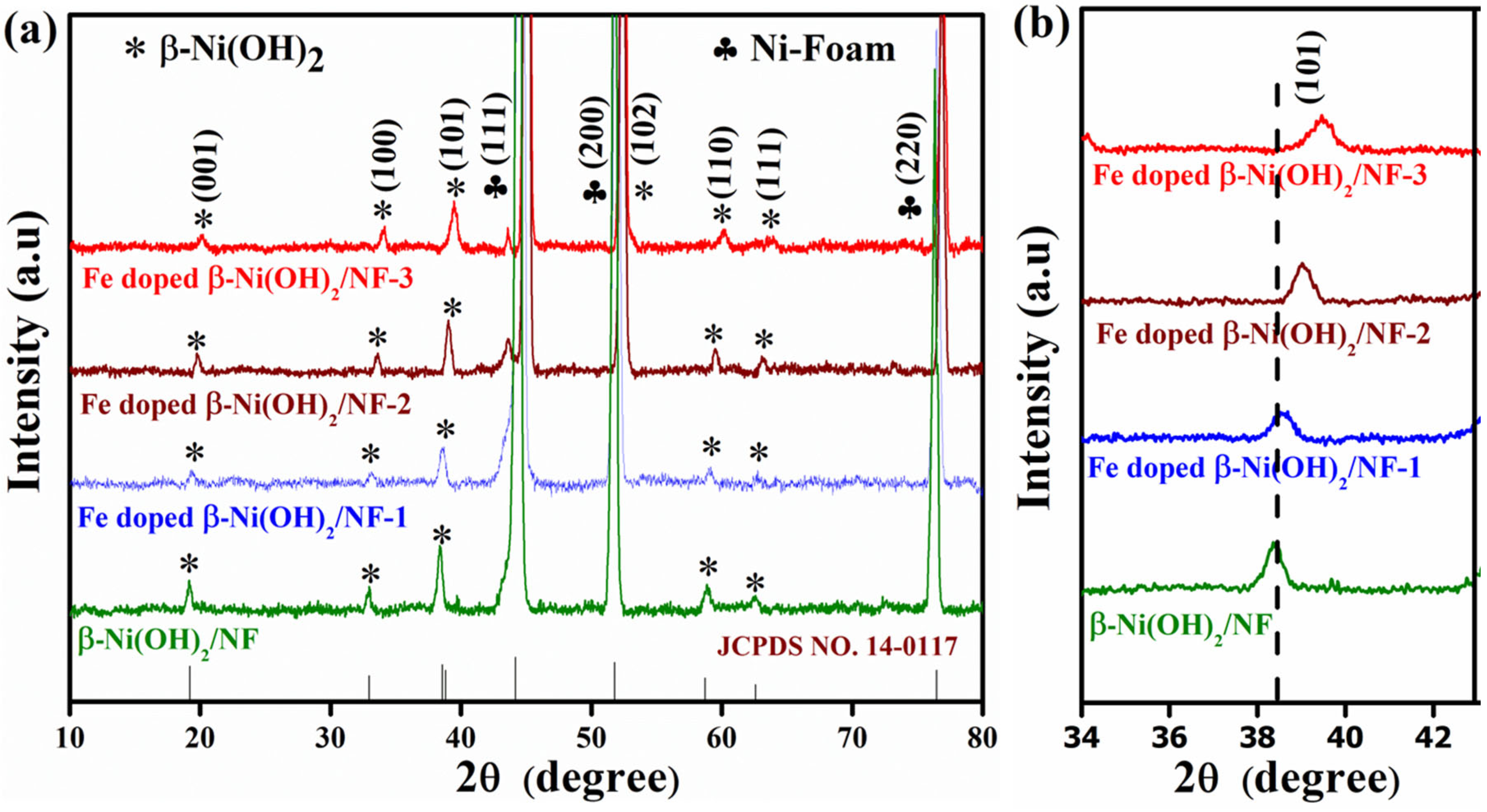

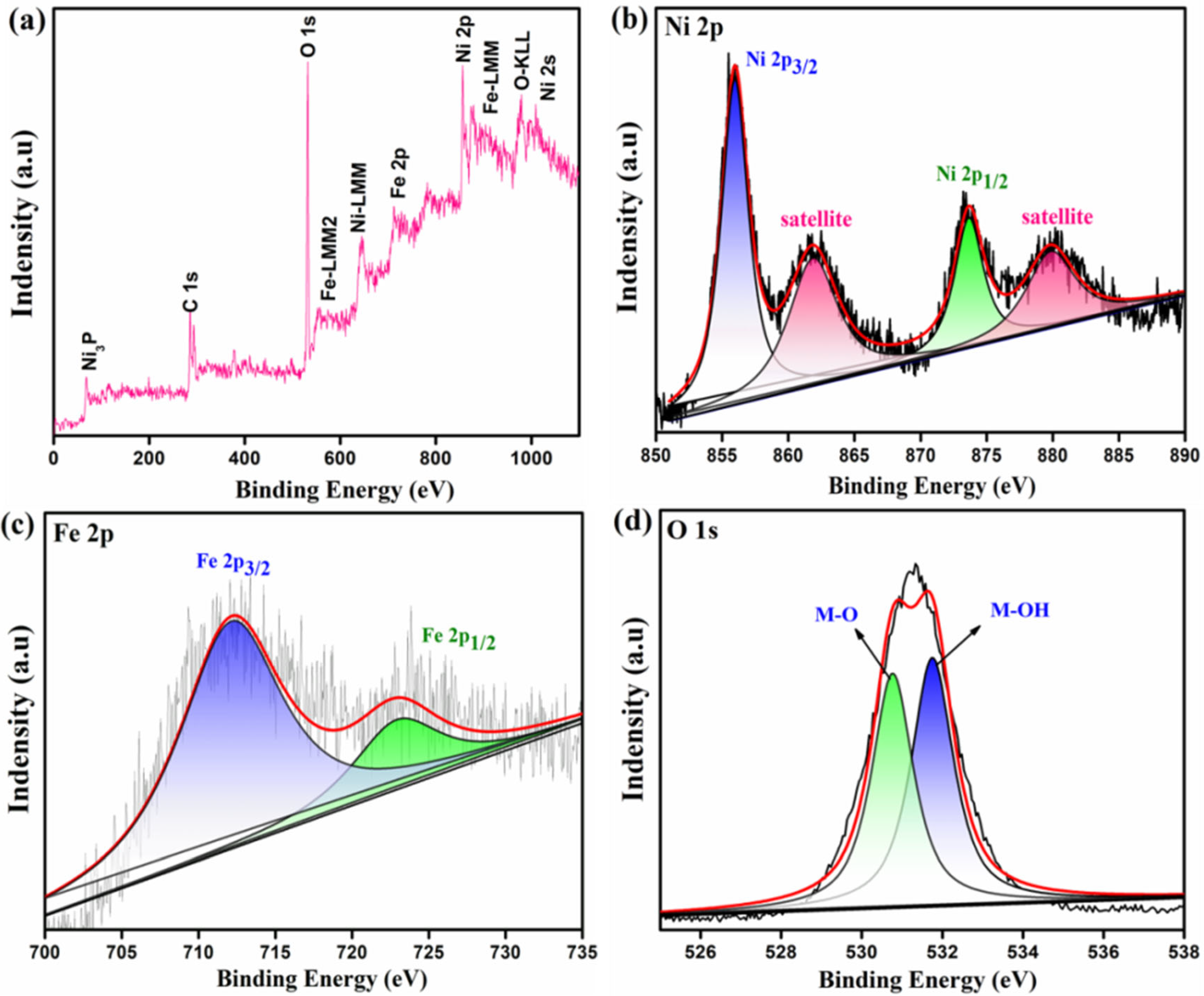
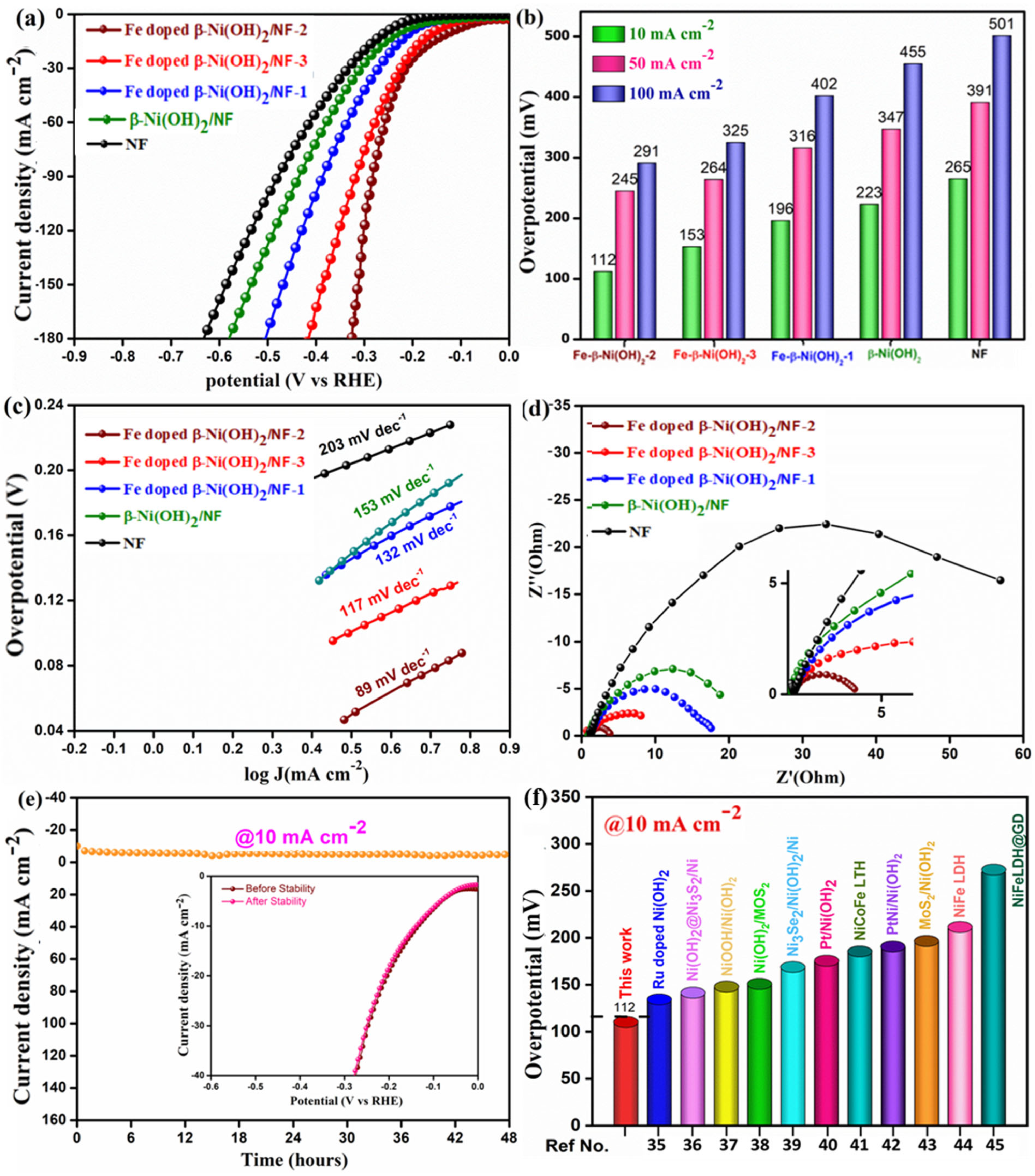

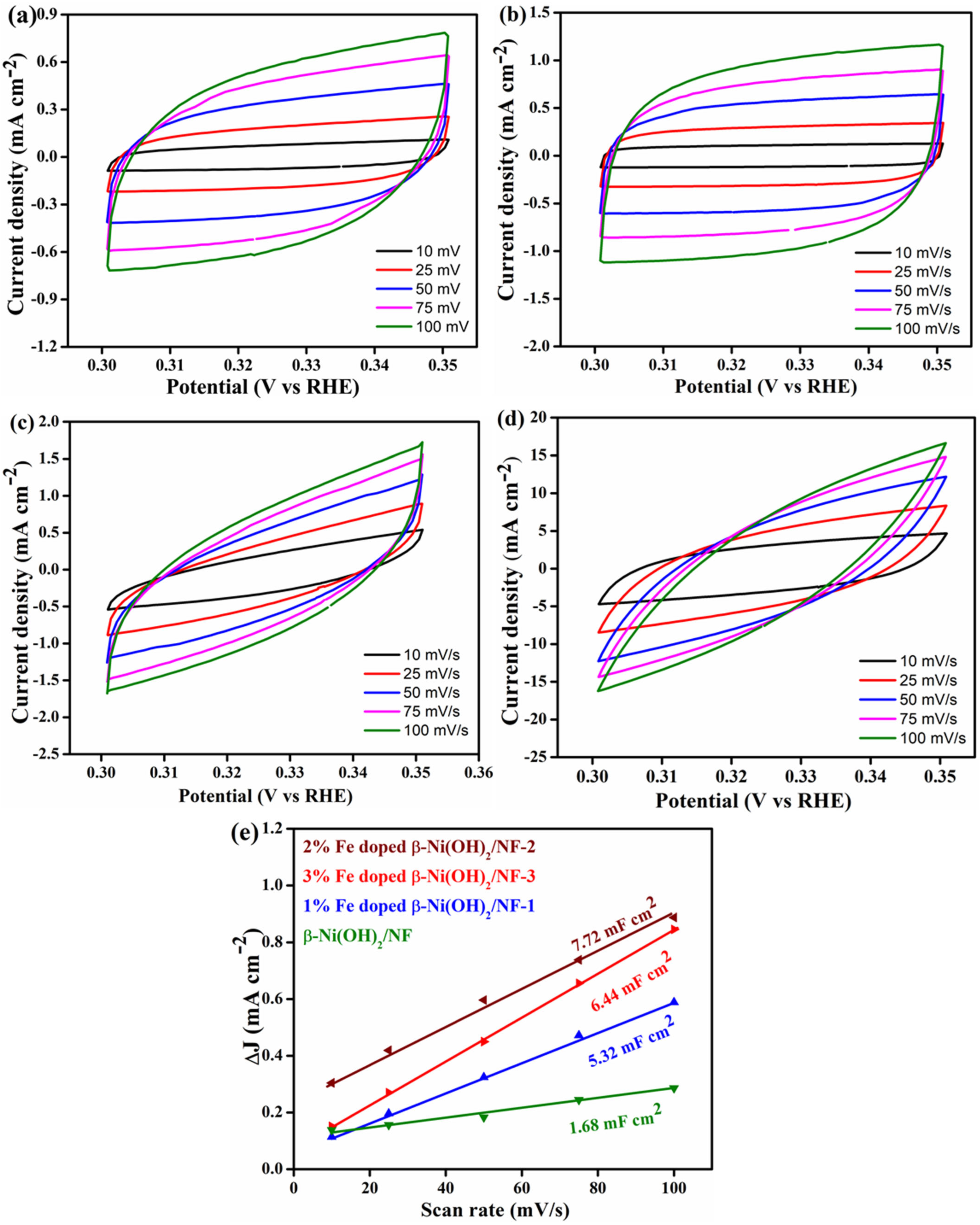
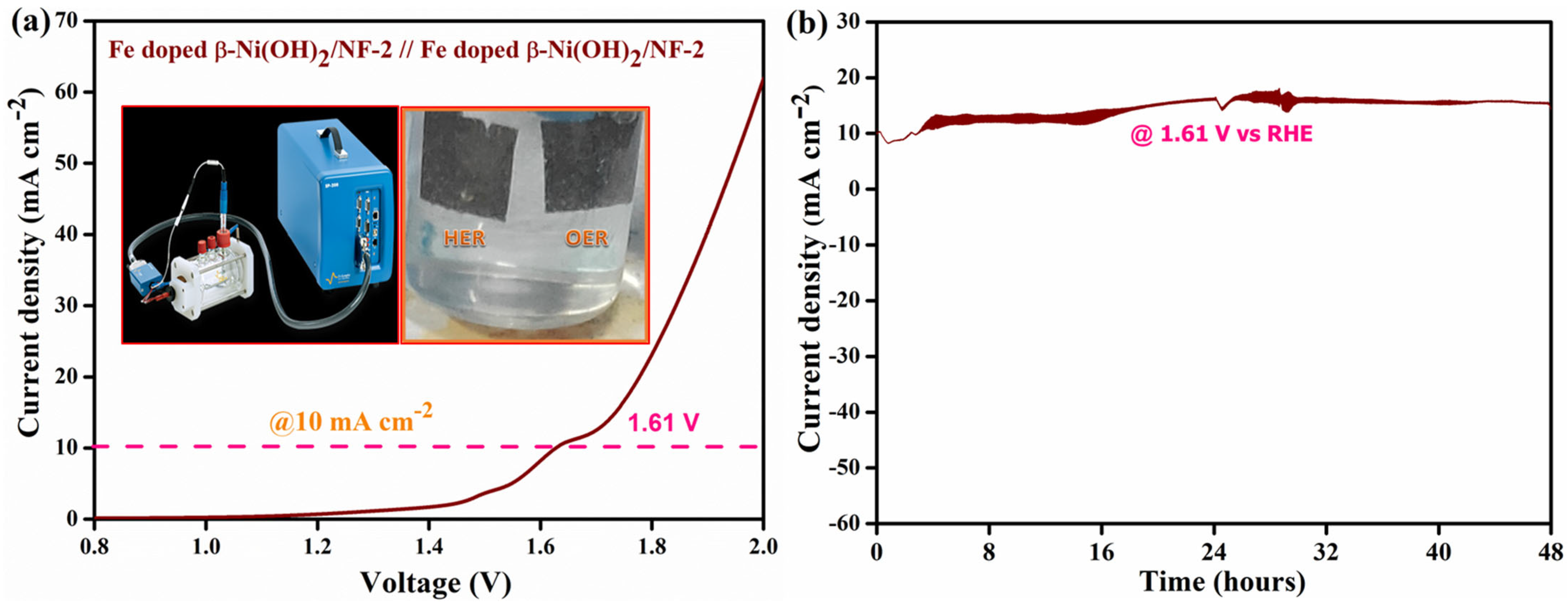
| Catalyst | ηonset (mV) | η (mV) at 10 mA cm−2 | j (mA cm−2) | Rct (Ω) | Tafel Slope mV dec−1 |
|---|---|---|---|---|---|
| Fe-doped β-Ni(OH)2/NF-2 | 56 | 112 | 245 | 4.3 | 89 |
| Fe-doped β-Ni(OH)2/NF-3 | 97 | 153 | 356 | 9.2 | 117 |
| Fe-doped β-Ni(OH)2/NF-1 | 137 | 196 | 453 | 18 | 132 |
| β-Ni(OH)2/NF | 165 | 223 | 340 | 20 | 153 |
| NF | 185 | 265 | 376 | 58 | 203 |
| Catalyst | Eonset (V) | ηonset (mV) | EOER (V) at 10 mA cm−2 | η (mV) at 10 mA cm−2 | j (mA cm−2) | Tafel Slope mV dec−1 |
|---|---|---|---|---|---|---|
| Fe-doped Ni(OH)2/NF-2 | 1.323 | 93 | 1.419 | 189 | 313 | 85 |
| Fe-doped Ni(OH)2/NF-3 | 1.349 | 119 | 1.454 | 224 | 310 | 94 |
| Fe-doped Ni(OH)2/NF-1 | 1.422 | 192 | 1.496 | 266 | 520 | 123 |
| β-Ni(OH)2/NF NF | 1.496 1.527 | 266 297 | 1.542 1.584 | 312 354 | 530 340 | 137 163 |
| Catalyst | Cdl (mF cm−2) | ECSA (cm2) |
|---|---|---|
| Fe-doped β-Ni(OH)2/NF-2 | 7.72 | 193 |
| Fe-doped β-Ni(OH)2/NF-3 | 6.44 | 161 |
| Fe-doped β-Ni(OH)2/NF-1 | 5.32 | 133 |
| β-Ni(OH)2/NF | 1.68 | 41 |
| Catalyst | EOER(V)@10 mA cm−2 | Reference |
|---|---|---|
| 2% Fe-doped Ni(OH)2/NF | 1.61 | Present Work |
| FeMoS2/Ni3S2/NF | 1.61 | [60] |
| Mo(1−x)Wx−S2@Ni3S2 | 1.62 | [61] |
| NiS/NiS2 | 1.62 | [62] |
| FeNi-LDH | 1.63 | [63] |
| N-Ni3S2/VS2 | 1.64 | [64] |
| Mo-doped Ni3S2 nanosheets | 1.67 | [65] |
| Fe-doped Ni(OH)2/NF | 1.67 | [66] |
Disclaimer/Publisher’s Note: The statements, opinions and data contained in all publications are solely those of the individual author(s) and contributor(s) and not of MDPI and/or the editor(s). MDPI and/or the editor(s) disclaim responsibility for any injury to people or property resulting from any ideas, methods, instructions or products referred to in the content. |
© 2023 by the authors. Licensee MDPI, Basel, Switzerland. This article is an open access article distributed under the terms and conditions of the Creative Commons Attribution (CC BY) license (https://creativecommons.org/licenses/by/4.0/).
Share and Cite
Krishnamurthy, P.; Maiyalagan, T.; Panomsuwan, G.; Jiang, Z.; Rahaman, M. Iron-Doped Nickel Hydroxide Nanosheets as Efficient Electrocatalysts in Electrochemical Water Splitting. Catalysts 2023, 13, 1095. https://doi.org/10.3390/catal13071095
Krishnamurthy P, Maiyalagan T, Panomsuwan G, Jiang Z, Rahaman M. Iron-Doped Nickel Hydroxide Nanosheets as Efficient Electrocatalysts in Electrochemical Water Splitting. Catalysts. 2023; 13(7):1095. https://doi.org/10.3390/catal13071095
Chicago/Turabian StyleKrishnamurthy, Palani, Thandavarayan Maiyalagan, Gasidit Panomsuwan, Zhongqing Jiang, and Mostafizur Rahaman. 2023. "Iron-Doped Nickel Hydroxide Nanosheets as Efficient Electrocatalysts in Electrochemical Water Splitting" Catalysts 13, no. 7: 1095. https://doi.org/10.3390/catal13071095
APA StyleKrishnamurthy, P., Maiyalagan, T., Panomsuwan, G., Jiang, Z., & Rahaman, M. (2023). Iron-Doped Nickel Hydroxide Nanosheets as Efficient Electrocatalysts in Electrochemical Water Splitting. Catalysts, 13(7), 1095. https://doi.org/10.3390/catal13071095









